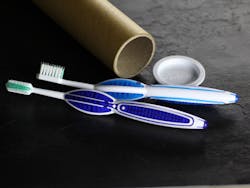The MD Brush formula: 1 part bristles, 2 parts handle, 3 parts education
Editor’s note: This article first appeared in the January-February issue of the Apex360 magazine. Not a subscriber? Click hereto sign up.
As you clicked through to this page of the magazine, you were probably thinking, “We’re living in an era during which 4-D printing is making the headlines. Why am I looking at a giant photo of manual toothbrushes in the ‘Technology Focus’ column of Apex360? What’s so technologically advanced about a manual toothbrush?” Well, I’m going to tell you what’s so advanced about it but only after you toss all of your preconceptions about patient homecare aside.
Go ahead — toss them.
That toothbrush you’re looking at is called the MD Brush, and yes, it is a manual brush. It’s a manual brush that promises to change the way that patients brush their teeth.
“But how?”
That was my first question too. Together, the features of the brush guide the user to employ the modified Bass technique of tooth brushing, a technique that has been shown to reduce bacterial growth below the gum line for healthy brushers and for those who have gingivitis or periodontal disease. Together, the features comprise a product that might reshape the way that the dental industry looks at manual brushing and patient homecare through its incorporation of education.
During a recent interview, Michael Davidson, RDH, BSDH, cofounder and President of MD Brush LLC, and Michael R. Smith, DDS, CEO and cofounder, explained their goals in developing the brush and how the design of the brush came to fruition.
“It just seemed to me [ … ] that gum disease wasn’t really a factor of the toothbrush or the product that was used,” said Davidson, who first conceptualized the brush with a clay model during 2007. “[Gum disease] was more a factor of what we were thinking and how we were using our arms. We would see patients in our practice, and we would just spend a little bit of time with them. We would explain to them what a sulcus is and what the objective of brushing is and kind of critique the way they were doing it. It made all the difference in the world as far as their periodontal health. And so, the question became, ‘How do you incorporate that same level of education into a product?’ So we started thinking about the grip, and what we see, and most importantly, the way things feel inside the mouth. That’s how we came up with the design.”
ORDERING INFORMATION
• 2 MD Brushes (subscription): $20 every 3 months
• 2 MD Brushes (non-subscription): $22
• 6 MD Brushes (non-subscription): $50
MD Brushes are shipped on the 1st and 15th of every month. To learn more or place an order, visit www.mdbrush.com.
Coupled with the visual indicators on the base of the handle, which allow the user to confirm via a mirror that the brush is being held in the correct position, the grip of the MD Brush is designed to teach the user to hold the brush at a 45-degree angle to the gum line. Meanwhile, the tapered “W-cut” bristles of the MD Brush are designed for optimal contact with the teeth and the gum line. The center row of tapered, green bristles cleans the gingival sulcus, while the white outer bristles clean the tooth and the exterior of the gum line.
The bristles, according to Davidson, were the most difficult component of building the brush because the brush incorporates two different types of bristles, not all of which could be added at once. The outer row of bristles had to be added first and then trimmed. The tapered bristles in the center row, which are about 3 mm longer than the exterior bristles, had to be added afterward.
The complex design of the brush led to a few other production issues for Davidson and Smith, as well. Originally, the goal was to have the brush manufactured in the United States. So, the duo hired a U.S. designer, and then they spoke to two toothbrush manufacturers.
“Both of them pretty much laughed at us,” said Davidson. “They said that it was too complicated to build, that it was going to be too expensive, that we didn’t know what we were getting into. It was a real struggle to get them to listen to us.”
Finally, they found a manufacturing facility in China that agreed to work with them. Davidson and Smith spent about 19 months working with the Chinese facility, but it ultimately didn’t work out. After that, they turned to a Japanese-owned company in Vietnam. While the handle on the prototype was, at first, too large, the company was committed to helping them get what they wanted out of the product — something that would teach patients “what proper brushing feels like,” in Davidson’s words.
“Really, MD Brush is not necessarily about a product. It’s about an education and about changing a [behavioral] pattern that precipitates gum disease,” said Davidson.
The MD Brush education doesn’t end with the dual-patented product design. Smith and Davidson are also invested in educating customers about the relationship between periodontal health and systemic disease and in promoting proper toothbrush replacement habits. Customers who sign up to receive the brush can opt in to a subscription program through which new brushes are shipped right to their doors every three months.
Since the November 2014 launch, feedback has been positive, and fulfilling the demand has been challenging for Smith and Davidson, both of whom are still practicing clinicians. In fact, about 30% of the dental professionals who signed up to receive a free sample brush prior to the launch later placed an order to purchase the brush.
“I’ve sent it out to quite a few dentists around the nation, and I’ve gotten really good feedback from all of them. They like the design, they like the feel of the brush, they like the way it brushes […] with the modified Bass technique,” said Smith.
Clinicians aren’t the only ones who are noticing the innovative design of the brush. One company has already approached Davidson and Smith about licensing the technology for a pediatric brush. But that’s not in the cards for the two-person enterprise right now. “We want to take it as far as possible between the two of us, until we can’t handle it anymore,” said Smith.
A pediatric brush will, however, be coming soon. The design has already been completed, and with a few more tweaks, it will be ready for manufacturing. After seven long years of research and development, hard work, and patience, and with visions for toothpaste and floss, the MD Brush product line – or rather, the MD Brush education – is just getting started.
About the Author

Erin Robinson
Erin Robinson, MA, is an associate editor in the dental group at Endeavor Business Media (formerly PennWell). Prior to joining the dental team at PennWell, she completed a master's degree at the University of Tulsa, where she taught professional writing to students majoring in business, engineering, and the natural sciences. To contact her or submit an article, email [email protected].

